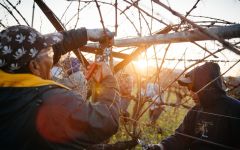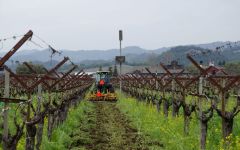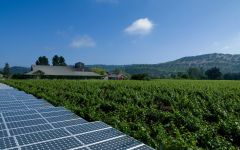Frog's Leap Napa Valley Chardonnay 2015
-
Wine &
Spirits -
Wilfred
Wong



Product Details
Your Rating
Somm Note
Winemaker Notes
Professional Ratings
-
Wine & Spirits
On several recent visits to Frog’s Leap, John Williams has detoured me from queries about cabernet and zinfandel to taste his chardonnay. He and his team have been developing a new strategy: pick at the underside of ripeness; whole-cluster press; settle for two days, then rack into new oak barrels; allow the fermentation to begin on its own and reach its peak (four or five days); then, with half the sugar remaining in the grapes, rack the wine to lined cement tanks to finish whatever it’s going to do, undisturbed for another nine months. Up until now, I’ve been more curious about his quixotic focus on chardonnay from Napa Valley, of all places, than about the wine itself. This vintage comes from Truchard and a nearby vineyard on Stanly Road, picking up on the best aspects of Carneros fruit—desert citrus cooled by the fog. It’s tart with baked lemon and grapefruit flavors, zesty in the middle and then richer in the end. The finish tastes like salted caramels, but it’s completely savory…and brisk. Williams’s goal is to make a great chardonnay that’s expressive of its origins in Napa Valley and his 2015 may give you a new perspective on that possibility.
-
Wilfred Wong of Wine.com
A top-flight Chardonnay, the wild and active 2015 Frog's Leap exhibits dried peach skin and savory herbs in its flavors. The wine's crisp finish pairs it superbly with stir-fried red snapper topped with al dente celery, bean sprouts, and yellow onions. (Tasted: September 7, 2017, San Francisco, CA)
Other Vintages
2017-
Wilfred
Wong
-
Wilfred
Wong
-
Wilfred
Wong
-
Wilfred
Wong
-
Wine
Enthusiast
-
Wine
Enthusiast
-
Wine &
Spirits
-
Wine &
Spirits






Frog's Leap is a family-owned winery dedicated to sustainable principles and committed to producing wines with balance, restraint and respect for terroir. Frog's Leap makes its home amongst 200 acres of vineyards in Rutherford at the historic ‘Red Barn’. Founded by John Williams in 1981, Frog’s Leap continues to be family-owned and operated. As the owner and winemaker, John has made every vintage for over four decades. Frog’s Leap has earned an enviable reputation for our sincere dedication to sustainable principles and our commitment to handcrafting wines. This noted ‘ghost winery’ was built in 1884 as the Adamson Winery and renovated in 1994 as Frog's Leap's permanent home. A handsome bi-level barrel chai completes the state-of-the-art winemaking facility and guests are received in the warm and welcoming LEED-certified hospitality center.
Now in its fourth decade of production, Winemakers John and Rory Williams hand-craft Sauvignon Blanc, Chardonnay, Zinfandel, Merlot, and an Estate-Grown Rutherford Cabernet Sauvignon. Using the best of Napa Valley's organically grown, dry- farmed grapes and the most traditional winemaking techniques, Frog's Leap strives to produce wines that deeply reflect the soils and climate from which they emanate. Thoughtfully shepherding both natural and earned resources, Frog’s Leap consistently returns more than it takes from the environment.
First certified by California Certified Organic Farmers (CCOF) in 1988 Frog's Leap has been a leader in the industry for decades. Fundamentally, organic farming means that if you take from the soil, you must return to the soil in equal measure. In the case of regenerative farming – a practice firmly embraced by Frog's Leap – you must return to the soil in greater measure than you take. Using a traditional approach to winemaking Frog’s Leap’s intention is to craft wines that are deeply reflective of the influences from which they emanate. Frog’s Leap makes wine of balance and restraint, with respect for the natural expression of the vine. The winery relies on techniques such as crop rotation, green manure, compost and biological pest control to maintain soil productivity and control pests on a farm. Organic farming excludes the use of manufactured fertilizers and pesticides, plant growth regulators and genetically modified organisms. Organic farming involves mechanical weed control (via cultivating or hoeing) rather than herbicidal weed control.
Frog's Leap presents a relaxed approach to enjoying wine. An easy hospitality and warm sense of humor is juxtaposed with a more serious sensibility when making wine. The wines produced range from Cabernet Sauvignon and Chardonnay to Zinfandel and Sauvignon Blanc. The winery has quite the line up to offer and hope you’ll try one of these delicious wines that harmoniously combine quality, sustainability and value.

One of the most popular and versatile white wine grapes, Chardonnay offers a wide range of flavors and styles depending on where it is grown and how it is made. While it tends to flourish in most environments, Chardonnay from its Burgundian homeland produces some of the most remarkable and longest lived examples. California produces both oaky, buttery styles and leaner, European-inspired wines. Somm Secret—The Burgundian subregion of Chablis, while typically using older oak barrels, produces a bright style similar to the unoaked style. Anyone who doesn't like oaky Chardonnay would likely enjoy Chablis.

One of the world's most highly regarded regions for wine production as well as tourism, the Napa Valley was responsible for bringing worldwide recognition to California winemaking. In the 1960s, a few key wine families settled the area and hedged their bets on the valley's world-class winemaking potential—and they were right.
The Napa wine industry really took off in the 1980s, when producers scooped up vineyard lands and planted vines throughout the county. A number of wineries emerged, and today Napa is home to hundreds of producers ranging from boutique to corporate. Cabernet Sauvignon is definitely the grape of choice here, with many winemakers also focusing on Bordeaux blends. White wines from Napa Valley are usually Chardonnay and Sauvignon Blanc.
Within the Napa Valley lie many smaller sub-AVAs that claim specific wine characteristics based on situation, slope and soil. Farthest south and coolest from the influence of the San Pablo Bay is Carneros, followed by Coombsville to its northeast and then Yountville, Oakville and Rutherford. Above those are the warm St. Helena and the valley's newest and hottest AVA, Calistoga. These areas follow the valley floor and are known generally for creating rich, dense, complex and smooth red wines with good aging potential. The mountain sub appellations, nestled on the slopes overlooking the valley AVAs, include Stags Leap District, Atlas Peak, Chiles Valley (farther east), Howell Mountain, Mt. Veeder, Spring Mountain District and Diamond Mountain District. Napa Valley wines from the mountain regions are often more structured and firm, benefiting from a lot of time in the bottle to evolve and soften.
